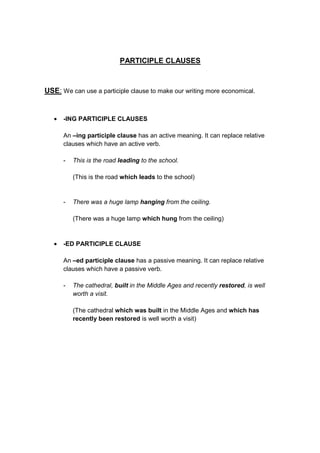Participle clauses
- 1. PARTICIPLE CLAUSES USE: We can use a participle clause to make our writing more economical. âĒ -ING PARTICIPLE CLAUSES An âing participle clause has an active meaning. It can replace relative clauses which have an active verb. - This is the road leading to the school. (This is the road which leads to the school) - There was a huge lamp hanging from the ceiling. (There was a huge lamp which hung from the ceiling) âĒ -ED PARTICIPLE CLAUSE An âed participle clause has a passive meaning. It can replace relative clauses which have a passive verb. - The cathedral, built in the Middle Ages and recently restored, is well worth a visit. (The cathedral which was built in the Middle Ages and which has recently been restored is well worth a visit)

